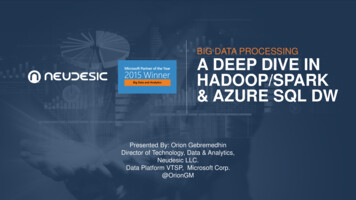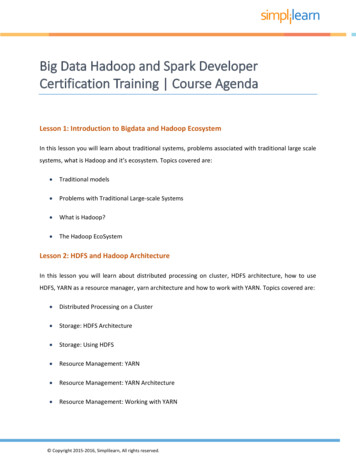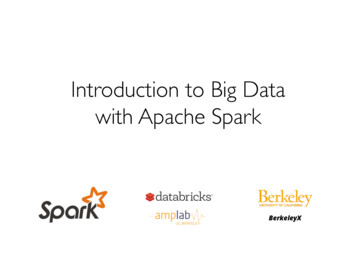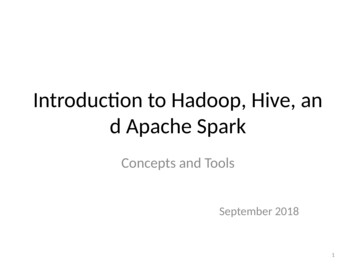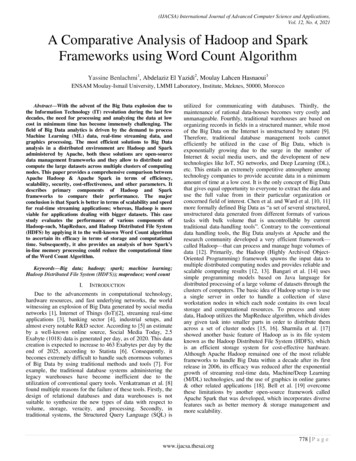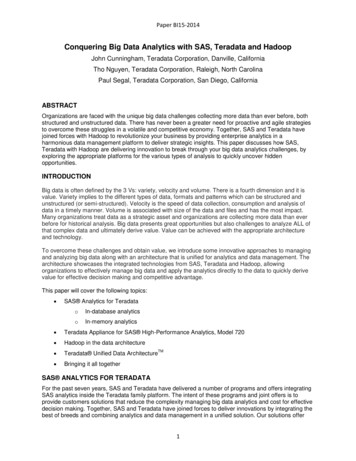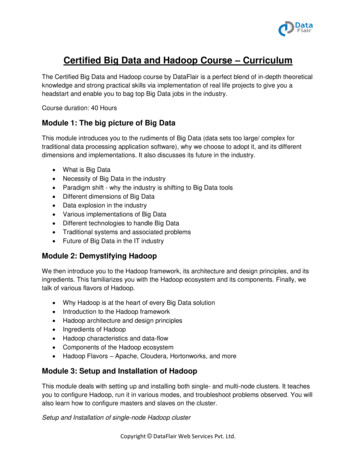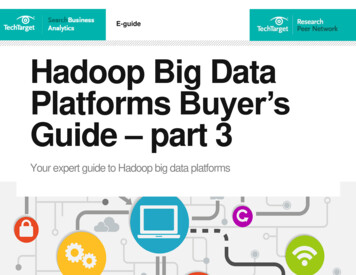
Transcription
Big Data Hadoop & SparkCertification TrainingIn Collaboration with IBMBig Data Hadoop & Spark Certification Training1 Page
Table of Contents1.About the Program2.Collaborating with IBM3.About Intellipaat4.Key Features5.Career Support6.Why take up this course?7.Who should take up this course?8.Program Curriculum9.Self-paced Courses10.Project Work11.Certification12.Intellipaat Success Stories13.Contact UsBig Data Hadoop & Spark Certification Training2 Page
About the ProgramIntellipaat’s Big Data Hadoop training program helps you master Big Data Hadoop andSpark to get ready for the Cloudera CCA Spark and Hadoop Developer Certification(CCA175) exam, as well as to master Hadoop Administration, through 14 real-timeindustry-oriented case-study projects. In this Big Data course, you will master MapReduce,Hive, Pig, Sqoop, Oozie, and Flume and work with Amazon EC2 for cluster setup, Sparkframework and RDDs, Scala and Spark SQL, Machine Learning using Spark, SparkStreaming, etc.Big Data Hadoop & Spark Certification Training3 Page
Collaborating with IBMIBM is one of the leading innovators and the biggest player in creating innovative tools forBig Data Analytical tools. Top subject matter experts from IBM will share knowledge in thedomain of Analytics and Big Data through this training program that will help you gain thebreadth of knowledge and industry experience.Benefits for students from IBM Industry-recognized IBM certificate Access to IBM Watson for hands-on training and practice Industry in-line case studies and project workAbout IntellipaatIntellipaat is one of the leading e-learning training providers with more than 600,000learners across 55 countries. We are on a mission to democratize education as webelieve that everyone has the right to quality education.Our courses are delivered by subject matter experts from top MNCs, and our world-classpedagogy enables learners to quickly learn difficult topics in no time. Our 24/7 technicalsupport and career services will help them jump-start their careers in their dreamcompanies.Big Data Hadoop & Spark Certification Training4 Page
Key Features60 HRS INSTRUCTOR-LEDTRAINING80 HRS SELF-PACED TRAINING120 HRS REAL-TIMEPROJECT WORKLIFETIME ACCESS24/7 TECHNICAL SUPPORTINDUSTRY-RECOGNIZEDCERTIFICATIONJOB ASSISTANCE THROUGH400 CORPORATE TIE-UPSFLEXIBLE SCHEDULINGBig Data Hadoop & Spark Certification Training5 Page
Career SupportSESSIONS WITH INDUSTRY MENTORSAttend sessions from top industry experts and get guidance on how to boostyour career growthMOCK INTERVIEWSMock interviews to make you prepare for cracking interviews by top employersRESUME PREPARATIONGet assistance in creating a world-class resume from our career services teamBig Data Hadoop & Spark Certification Training6 Page
Why take up this course? Global Hadoop market to reach US 84.6 billion in 2 years – Allied Market Research The number of jobs for all the US data professionals will increase to 2.7 million peryear – IBM A Hadoop Administrator in the United States can get a salary of US 123,000 –IndeedBig Data is the fastest growing and the most promising technology for handling largevolumes of data for doing Data Analytics. This Big Data Hadoop training will help you beup and running in the most demanding professional skills. Almost all top MNCs are tryingto get into Big Data Hadoop; hence, there is a huge demand for certified Big Dataprofessionals. Our Big Data online training will help you learn Big Data and upgrade yourcareer in the domain.Who should take up this course? Programming Developers and System Administrators Experienced working professionals and Project Managers Big Data Hadoop Developers eager to learn other verticals such as testing,analytics, and administration Mainframe Professionals, Architects, and Testing Professionals Business Intelligence, Data Warehousing, and Analytics Professionals Graduates and undergraduates eager to learn Big DataBig Data Hadoop & Spark Certification Training7 Page
Program CurriculumBIG DATA HADOOP COURSE CONTENT1. HADOOP INSTALLATION AND SETUP1.1 The architecture of Hadoop cluster1.2 What is high availability and federation?1.3 How to setup a production cluster?1.4 Various shell commands in Hadoop1.5 Understanding configuration files in Hadoop1.6 Installing a single node cluster with Cloudera Manager1.7 Understanding Spark, Scala, Sqoop, Pig, and Flume2. Introduction to Big Data Hadoop and Understanding HDFS and MapReduce2.1 Introducing Big Data and Hadoop2.2 What is Big Data, and where does Hadoop fit in?2.3 Two important Hadoop ecosystem components, namely, MapReduce andHDFS2.4 In-depth Hadoop Distributed File System – Replications, Block Size, SecondaryName node, High Availability and in-depth YARN – resource manager and nodemanagerHands-on Exercise: HDFS working mechanism, data replication process, how todetermine the size of a block, and understanding a DataNode and a NameNode3. DEEP DIVE IN MAPREDUCE3.1 Learning the working mechanism of MapReduce3.2 Understanding the mapping and reducing stages in MR3.3 Various terminology in MR such as input format, output format, partitioners,combiners, shuffle, and sortHands-on Exercise: How to write a WordCount program in MapReduce? How to write aCustom Partitioner? What is a MapReduce Combiner? How to run a job in a local jobBig Data Hadoop & Spark Certification Training8 Page
runner? Deploying a unit test, What is a map-side join and reduce-side join?, What is a toolrunner? How to use counters, and dataset joining with map-side and reduce-side joins?4. INTRODUCTION TO HIVE4.1 Introducing Hadoop Hive4.2 Detailed architecture of Hive4.3 Comparing Hive with Pig and RDBMS4.4 Working with Hive Query Language4.5 Creation of a database, table, group by, and other clauses4.6 Various types of Hive tables and HCatalog4.7 Storing Hive results, Hive partitioning, and bucketsHands-on Exercise: Database creation in Hive, dropping a database, Hive table creation,how to change a database, data loading, dropping and altering a table, pulling data bywriting Hive queries with filter conditions, table partitioning in Hive, and using the Group byclause5. ADVANCED HIVE AND IMPALA5.1 Indexing in Hive5.2 The map-side join in Hive5.3 Working with complex data types5.4 The Hive user-defined functions5.5 Introduction to Impala5.6 Comparing Hive with Impala5.7 The detailed architecture of ImpalaHands-on Exercise: How to work with Hive queries, the process of joining a table andwriting indexes, external table and sequence table deployment, and data storage in adifferent table6. INTRODUCTION TO PIG6.1 Apache Pig introduction and its various features6.2 Various data types and schema in Pig6.3 The available functions in Pig, Hive bags, tuples, and fieldsBig Data Hadoop & Spark Certification Training9 Page
Hands-on Exercise: Working with Pig in MapReduce and in a local mode, loading of data,limiting data to four rows, storing the data into files, and working with group by, filter by,distinct, cross, and split7. FLUME, SQOOP, AND HBASE7.1 Apache Sqoop introduction7.2 Importing and exporting data7.3 Performance improvement with Sqoop7.4 Sqoop limitations7.5 Introduction to Flume and understanding the architecture of Flume7.6 What are HBase and the CAP theorem?Hands-on Exercise: Working with Flume for generating a sequence number andconsuming it, using Flume Agent to consume Twitter data, using AVRO to create a Hivetable, AVRO with Pig, creating a table in HBase, and deploying Disable, Scan, and Enabletable functions8. WRITING SPARK APPLICATIONS USING SCALA8.1 Using Scala for writing Apache Spark applications8.2 Detailed study of Scala8.3 The need for Scala8.4 The concept of object-oriented programming8.5 Executing the Scala code8.6 Various classes in Scala such as getters, setters, constructors, abstract,extending objects, and overriding methods8.7 The Java and Scala interoperability8.8 The concept of functional programming and anonymous functions8.9 Bobsrockets package and comparing the mutable and immutable collections8.10 Scala REPL, lazy values, control structures in Scala, directed acyclic graph(DAG), first Spark application using SBT/Eclipse, Spark Web UI, and Spark inHadoop ecosystemHands-on Exercise: Writing a Spark application using Scala and understanding therobustness of Scala for the Spark real-time analytics operationBig Data Hadoop & Spark Certification Training10 P a g e
9. SPARK FRAMEWORK9.1 Detailed Apache Spark and its various features9.2 Comparing with Hadoop9.3 Various Spark components9.4 Combining HDFS with Spark and Scalding9.5 Introduction to Scala9.6 Importance of Scala and RDDsHands-on Exercise: The resilient distributed dataset (RDD) in Spark, How does it helpspeed up Big Data processing?10. RDDS IN SPARK10.1 Understanding Spark RDD operations10.2 Comparison of Spark with MapReduce10.3 What is a Spark transformation?10.4 Loading data in Spark10.5 Types of RDD operations, viz. transformation and action10.6 What is a Key/Value pair?Hands-on Exercise: How to deploy RDDs with HDFS?, Using the in-memory dataset,using file for RDDs, how to define the base RDD from an external file? Deploying RDDs viatransformation, using the Map and Reduce functions, and working on word count andcount log severity11. DATAFRAMES AND SPARK SQL11.1 The detailed Spark SQL11.2 The significance of SQL in Spark for working with structured data processing11.3 Spark SQL JSON support11.4 Working with XML data and parquet files11.5 Creating Hive Context11.6 Writing a DataFrame to Hive11.7 How to read a JDBC file?11.8 Significance of a Spark DataFrames11.9 How to create a DataFrame?11.10 What is schema manual inferring?Big Data Hadoop & Spark Certification Training11 P a g e
11.11 Working with CSV files, JDBC table reading, data conversion from aDataFrame to JDBC, Spark SQL user-defined functions, shared variable, andaccumulators11.12 How to query and transform data in DataFrames?11.13 How a DataFrame provides the benefits of both Spark RDDs and Spark SQL11.14 Deploying Hive on Spark as the execution engineHands-on Exercise: Data querying and transformation using DataFrames and finding outthe benefits of DataFrames over Spark SQL and Spark RDDs12. MACHINE LEARNING USING SPARK (MLLIB)12.1 Introduction to Spark MLlib12.2 Understanding various algorithms12.3 What is Spark iterative algorithm?12.4 Spark graph processing analysis12.5 Introducing Machine Learning12.6 K-means clustering12.7 Spark variables like shared and broadcast variables12.8 What are accumulators?12.9 Various ML algorithms supported by MLlib12.10 Linear regression, logistic regression, decision tree, random forest, and kmeans clustering techniquesHands-on Exercise: Building a recommendation engine13. INTEGRATING APACHE FLUME AND APACHE KAFKA13.1 Why Kafka?13.2 What is Kafka?13.3 Kafka architecture13.4 Kafka workflow13.5 Configuring Kafka cluster13.6 Basic operations13.7 Kafka monitoring tools13.8 Integrating Apache Flume and Apache KafkaBig Data Hadoop & Spark Certification Training12 P a g e
Hands-on Exercise: Configuring single node single broker cluster, configuring singlenode multi broker cluster, producing and consuming messages, and integrating ApacheFlume and Apache Kafka14. SPARK STREAMING14.1 Introduction to Spark Streaming14.2 The architecture of Spark Streaming14.3 Working with the Spark Streaming program14.4 Processing data using Spark Streaming14.5 Requesting count and DStream14.6 Multi-batch and sliding window operations14.7 Working with advanced data sources14.8 Features of Spark Streaming14.9 Spark Streaming workflow14.10 Initializing StreamingContext14.11 Discretized Streams (DStreams)14.12 Input DStreams and Receivers14.13 Transformations on DStreams14.14 Output operations on DStreams14.15 Windowed operators and its uses14.16 Important windowed operators and stateful operatorsHands-on Exercise: Twitter Sentiment Analysis, streaming using netcat server, Kafka–Spark Streaming, and Spark–Flume Streaming15. HADOOP ADMINISTRATION – MULTI - NODE CLUSTER SETUP USINGAMAZON EC215.1 Create a 4-node Hadoop cluster setup15.2 Running the MapReduce Jobs on the Hadoop cluster15.3 Successfully running the MapReduce code15.4 Working with the Cloudera Manager setupHands-on Exercise: Building a multi-node Hadoop cluster using an Amazon EC2instance and Working with the Cloudera ManagerBig Data Hadoop & Spark Certification Training13 P a g e
16. HADOOP ADMINISTRATION – CLUSTER CONFIGURATION16.1 Overview of Hadoop configuration16.2 The importance of Hadoop configuration file16.3 The various parameters and values of configuration16.4 HDFS parameters and MapReduce parameters16.5 Setting up the Hadoop environment16.6 Include and exclude configuration files16.7 The administration and maintenance of NameNode, DataNode, directorystructures, and files16.8 What is a File system image?16.9 Understanding the edit logHands-on Exercise: The process of performance tuning in MapReduce17. HADOOP ADMINISTRATION: MAINTENANCE, MONITORING, ANDTROUBLESHOOTING17.1 Introduction to the checkpoint procedure, NameNode failure17.2 How to ensure the recovery procedure, safe mode, metadata and databackup, various potential problems and solutions, and what to look for and how toadd and remove nodesHands-on Exercise: How to go about ensuring the MapReduce File System Recoveryfor different scenarios, JMX monitoring of the Hadoop cluster, How to use the logs andstack traces for monitoring and troubleshooting, Using the Job Scheduler for schedulingjobs in the same cluster, Getting the MapReduce job submission flow, FIFO schedule,and Getting to know the Fair Scheduler and its configuration18. ETL CONNECTIVITY WITH HADOOP ECOSYSTEM (SELF-PACED)18.1 How do ETL tools work in Big Data industry?18.2 Introduction to ETL and data warehousing18.3 Working with prominent use cases of Big Data in the ETL industry18.4 End-to-end ETL PoC showing Big Data integration with the ETL toolBig Data Hadoop
1.4 Various shell commands in Hadoop 1.5 Understanding configuration files in Hadoop 1.6 Installing a single node cluster with Cloudera Manager 1.7 Understanding Spark, Scala, Sqoop, Pig, and Flume 2. Introduction to Big Data Hadoop and Understanding HDFS and MapReduce 2.1 Introducing Big Data and Hadoop 2.2 What is Big Data, and where does Hadoop fit in? 2.3 Two important Hadoop ecosystem .
